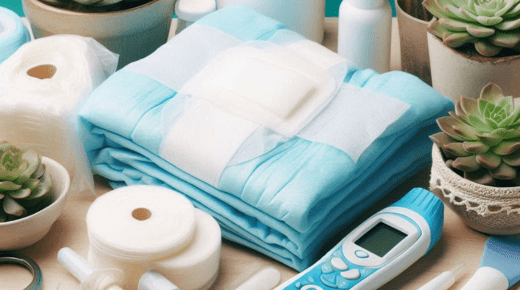Incontinence, or the loss of bladder control, is a common condition that affects millions of people worldwide. It can be a challenging issue, impacting not only physical health but also emotional well-being and quality of life. However, with the right knowledge, support, and products, managing incontinence effectively is possible. This comprehensive guide will help you understand incontinence, explore its causes, and provide practical tips for managing bladder control.
What is Incontinence?
Incontinence refers to the involuntary leakage of urine, which can range from occasional dribbles to a complete loss of bladder control. It can affect people of all ages, though it is more common in older adults and women. Incontinence is not a disease but rather a symptom of underlying conditions or changes in the body.
Types of Incontinence
- Stress Incontinence: Occurs when physical activities like coughing, sneezing, laughing, or exercising put pressure on the bladder, leading to urine leakage. It is often associated with weakened pelvic floor muscles, which can result from childbirth, menopause, or aging.
- Urge Incontinence: Also known as overactive bladder, urge incontinence is characterized by a sudden, intense urge to urinate followed by involuntary leakage. It can be caused by conditions such as urinary tract infections, neurological disorders, or bladder irritants.
- Overflow Incontinence: This occurs when the bladder cannot empty completely, leading to frequent dribbling of urine. It can be caused by conditions that block the flow of urine, such as an enlarged prostate, or by nerve damage.
- Functional Incontinence: Functional incontinence occurs when a person is unable to reach the bathroom in time due to physical or cognitive impairments, such as arthritis or dementia.
- Mixed Incontinence: A combination of two or more types of incontinence, most commonly stress and urge incontinence.
Causes of Incontinence
Incontinence can result from various factors, including:
- Weak Pelvic Floor Muscles: Often weakened by pregnancy, childbirth, or aging, these muscles are crucial for bladder control.
- Hormonal Changes: Menopause can lead to a decrease in estrogen, weakening the urethra and bladder muscles.
- Prostate Problems: Men with enlarged prostates or those who have undergone prostate surgery may experience incontinence.
- Neurological Disorders: Conditions like Parkinson’s disease, multiple sclerosis, and spinal cord injuries can disrupt nerve signals that control the bladder.
- Medications: Certain medications, such as diuretics or muscle relaxants, can contribute to incontinence.
- Chronic Health Conditions: Diabetes, obesity, and chronic urinary tract infections can also increase the risk of incontinence.
Managing Incontinence: Practical Tips and Solutions
While incontinence can be challenging, there are many strategies and products available to help manage the condition effectively.
1. Pelvic Floor Exercises (Kegels)
Strengthening the pelvic floor muscles is one of the most effective ways to improve bladder control. Kegel exercises involve tightening and relaxing the muscles that control urination. Regular practice can help reduce the symptoms of stress incontinence and improve overall bladder control.
2. Bladder Training
Bladder training involves gradually increasing the time between bathroom visits to help improve bladder capacity and control. This technique is particularly useful for managing urge incontinence. Start by scheduling bathroom visits every 1-2 hours and gradually increase the interval as your bladder control improves.
3. Dietary Modifications
Certain foods and beverages can irritate the bladder and worsen incontinence symptoms. Common bladder irritants include caffeine, alcohol, carbonated drinks, spicy foods, and acidic fruits. Identifying and reducing these triggers can help minimize leakage and improve bladder control.
4. Incontinence Products
There is a wide range of incontinence products available to help manage symptoms and provide comfort and protection. These include:
- Absorbent Pads and Liners: Designed to absorb small to moderate amounts of urine, these products are discreet and can be worn inside underwear.
- Incontinence Underwear: Also known as adult diapers or pull-ups, these provide more substantial protection for those with moderate to heavy incontinence.
- Bed Pads and Chair Protectors: These products protect bedding and furniture from leaks and can be easily washed and reused.
- Catheters: For individuals with severe incontinence, catheters may be necessary to drain urine from the bladder.
5. Lifestyle Adjustments
Making certain lifestyle changes can help manage incontinence effectively. These include:
- Maintaining a Healthy Weight: Excess weight can put pressure on the bladder, worsening incontinence symptoms. Achieving and maintaining a healthy weight can reduce this pressure and improve bladder control.
- Quitting Smoking: Smoking can irritate the bladder and increase the risk of incontinence. Quitting smoking can help reduce this risk and improve overall health.
- Scheduled Bathroom Visits: Establishing a regular bathroom schedule can help prevent accidents, especially for those with functional incontinence.
6. Seek Medical Advice
If incontinence is affecting your quality of life, it’s important to seek medical advice. A healthcare provider can help determine the underlying cause of incontinence and recommend appropriate treatments, which may include medication, physical therapy, or surgery.
Incontinence is a common condition that can be managed effectively with the right strategies and products. Understanding the different types of incontinence, their causes, and the available management options can help individuals regain control and improve their quality of life. Whether through pelvic floor exercises, dietary modifications, or the use of incontinence products, there are many ways to manage bladder control issues and live a comfortable, active life. If you’re struggling with incontinence, don’t hesitate to seek professional help to explore the best solutions for your needs. Search for wound dressing when there are decubitus wounds.

